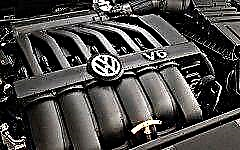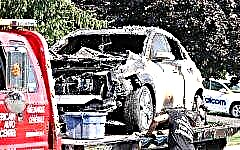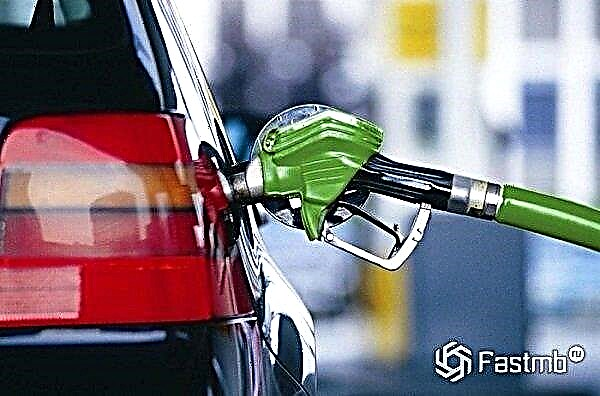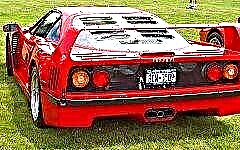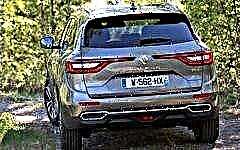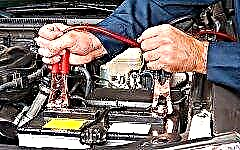

The content of the article:
- History of creation
- Protection principle
- Main characteristics
- Pros and cons
- Manufacturing steps
- Price
- Testimonials
Triplex glass is a laminated glass (a kind of cake), consisting of several glasses glued together with a special polymer film, silicate adhesives and other components that impart special density and resistance to damage. The process of creating such glass is called the triplexing method. The scope of application is very different, from the glazing of objects to technology, in our case, application in cars. From the Latin Triplex - triple, hence the corresponding name.
The first glass in cars was tempered, which is why they got the name Stalinite. They are stronger than ordinary ones, but with a strong impact they crumble into small parts, so it became unsafe to use them for the windshield and triplex glass began to be used as an alternative. Their peculiarity is that during the impact, it does not crumble into small parts, which means that it cannot cause serious injuries to passengers.
The history of the creation of triplex glass

For the first time, they started talking about triplex glass and production in 1909, when the French chemist Eduard Benedictus received a patent for his invention. Glassware was widespread at that time, especially among chemists. Inadvertently, a glass flask with a chemical reagent fell to the floor and did not break.
The scientist saw that the flask was cracked, but at the same time retained its shape. Earlier, Benedictus had repeatedly heard about cases with cars and the consequences of accidents, injuries to passengers, especially drivers from glass fragments. It was these cases that made him create triplex glass. Subsequently, the invention not only reduced injuries, but also began to be used in the field of safety (booking).
Triplex glass protection principle

As already mentioned, the main property of triplex glass is protection, strength and integrity, and the higher the protection class, the safer it is. Special requirements are imposed on the windshield of a car; it must be strong and aerodynamic.
The protection function can be divided depending on the purpose of the glass and the structure of the building. In the automotive industry, several versions of the triplex are used. How does the principle of triplex protection work? The main property of such glass is its integrity, if it is broken, then it does not crumble into small pieces, which is very important for the windshield of a car. Depending on the make and model of the car, the manufacturer may use different windshield options.

Mostly divided into standard - about 6 mm, used for most types of cars. This option can protect against a thrown stone, bottle or other elements that can easily break ordinary tempered glass. We can say the most common option and the most used by all manufacturers.
The second variant of triplex glass is protective, with a total thickness of 8 and 10 mm. This is a modernized version of the standard, with thicker glasses. This type is an order of magnitude stronger and can withstand direct blows from a heavy object and protect the car from vandalism. In addition to the windshield, this type is often used by manufacturers for the side and rear windows of the car.

The last, third version is bulletproof triplex or, as they say, armored, of the SZP-1, 2 and 3 standard. They are considered the most expensive and thickest from 18 to 38 mm, although this is rather a standard, non-standard options may differ in maximum thickness. According to various sources, such a triplex is capable of withstanding a TT or SVD pistol (for the thickest package). In the photo above, you can see the result of shooting from a similar weapon at bullet-resistant glasses.
In any of the induced options, the principle of protection can be said to be the same, and depending on the used film, glass thickness, density and adhesive materials, the degree and possibilities depend. As already mentioned, often a triplex consists of three elements, hence the corresponding name. Two glasses glued together with a special film and adhesive materials give special strength, and therefore resistance to external damage.
When the object hits the triplex glass, the upper layer is always broken, but in some cases the lower one may remain intact. The feature is all in the film, it should work as a barrier or shock absorber and distributes the impact force over the entire area of the glass. On the Internet, you can find many photos, situations and other moments when sharp, heavy objects pierced this type of glass and the passengers did not receive any injuries. Even if the triplex autoglass is punched through, then only the impact area remains damaged, and splinters in a minimum amount fall into the passenger compartment. Each manufacturer has its own secrets for making triplex, but the technology and the result are often the same, and the whole secret lies in the film and components between the inner and outer glass.
Triplex glass characteristics

The main and main characteristic of triplex glass is its subsequent purpose. As already mentioned, there are 3 main options - standard, reinforced and bulletproof (bulletproof). Naturally, depending on this, there will be the cost, as well as the thickness of the package itself. If we talk about the thickness, then there are no definite frames, rather they are approximate. Standard triplex from 5 to 6 mm, sometimes a 7 mm package is also referred to as the standard version.
Thickness from 8 mm to 10 mm - "reinforced", some manufacturers manage to increase the thickness to 16-17 mm, while pointing to the "reinforced plus" class. This type has not yet grown to the "bulletproof" class, but is also capable of withstanding impacts from very heavy objects. The last third version of glass is triplex "bulletproof", the minimum glass thickness is from 18 mm, the average maximum thickness of the package is 38 mm, but some manufacturers expand to a thickness that will allow the triplex to sit in the designated place, including on the door leaf.

The photo shows a chip on the rear window of a triplex
All triplex glasses, regardless of thickness and class, have a number of important safety characteristics:
- increased impact resistance;
- in the event of a strong impact, a crack may appear on the glass, which does not subsequently extend to the entire area of the drips. In some cases, triplex autoglass can get a small chip, which can be easily removed with a special glue, while not removing the glass from the car;
- if this type of glass received a through crack, then the fragments do not fly around the cabin, but remain on the film. This is a plus for the safety of passengers, especially at high speed;
- triplex glass is hard to break for an intruder in case of an attempt to get into the salon.
As statistics show, in most cases, the installation of triplex is preferable for windshield car windows, but some manufacturers install it as a rear window or side window.

In addition to the main characteristics, triplex autoglass can be with current heating, increased noise absorption properties, with a mirror shade, black (tinted) or colored. To distinguish high-quality glass from a fake, you can use several criteria, firstly, the shape of the edges has a thorough factory processing, as well as consistent dimensions.Secondly, a quality product should not contain air bubbles, debris or chips, as this leads to a decrease in the strength of the glass.
Pros and cons of triplex glasses

Like any technology, triplex glass has its pros and cons. If we figured out the pluses before, having considered the characteristics and the principle of protection, then the minuses are in the production itself and in the possibilities. It is almost impossible to make such glass in a garage without special equipment, as there will be rejects and loss of material. To make it clearer, what are the pros and cons of triplex glass, we will display the information in a table, and also compare it with glass known as "stalinite".
| Advantages and disadvantages of triplex and stalinite glass | |||
| Autoglass triplex | Stalinite glass | ||
| Benefits | disadvantages | Benefits | disadvantages |
| High impact resistance | High price | Relatively low price | Shatter |
| Temperature resistant | Manufacturing only to order | Uncomplicated manufacturing technology | Low impact resistance |
| Penetration resistance | Heavy weight (bulletproof) | The shards are blunt | Glass cannot be restored |
| Resistant to moisture and heat | Probability of marriage | UV protection | Not scratch resistant |
| Resistant to shattering | The quality is proportionally dependent on the film | Environmental friendliness | — |
| Functional spectrum (color change, electric heating, etc.) | Sophisticated manufacturing technology | Resistant to moisture and heat | — |
| Environmental friendliness | Bulletproof require registration with the traffic police and a certificate | Life span 15-20 years | — |
| UV protection | — | Weighs a little | — |
| Possibility of repairing damaged glass | — | — | — |
| Life span 25-50 years | — | — | — |
| Scratch resistant | — | — | — |
By pointing out the pros and cons of triplex and stalinite, the main differences immediately become clear. Avid car enthusiasts remember how for the first time special car windows were introduced to the market, which in a split second could turn from transparent glass to tinted glass. At the time of its appearance, this was a huge breakthrough in technology, since in fact it was impossible to prove the presence of tinting. It was this technology that was first tested and implemented on triplex glass.
Today, technologies allow not only making transparent triplex, but also changing shades, adding special inserts and patterns. In a word, the manufacturer does not limit the desire and imagination. Still, there are disadvantages, especially for bullet-proof glasses, they must be registered with the traffic police and receive the appropriate certificate. There is also a minus in the technology of manufacturing triplex glass itself, a film of poor quality or poor surface treatment can lead to the appearance of swelling, air bubbles and, of course, a decrease in the level of shock resistance and safety.
The process of making glass triplex for cars

From the above examples, you can understand that the process of making triplex glass for a car is not so simple. Special requirements are imposed on this type, which means that the quality must be maximum. There are several technologies for the manufacture of triplex glass, but the best quality is considered to be pressed glass when heated and glued together with a special PVB film (polyvinylbuteral film). The higher the quality of the film, the greater the impact resistance of the future product will be. The whole process of making triplex glass begins with the melting process itself. The resulting material for cutting should not contain flaws, grains of chemical elements and much more microcracks. All these nuances are checked after the glass sheets are cast and polished by fire. Respecting manufacturers, if such nuances are identified, can reject the entire batch.

On the windshield of the car, you can see bends and other non-standard shapes, all this is done by the manufacturer even before the creation of the triplex. In the form of special matrices, workers cut the sheets and feed them into the bending furnace (to give them a curved shape). Having received the ideal workpieces, the washing, drying and preparation process is repeated again, and only now the glasses are interconnected with polyvinylbuteral film (PVB). It is this film that gives elasticity and impact resistance, and in some cases, bulletproofness. During the impact, the film holds back fragments and prevents cracks from spreading.
The main stages in the manufacture of triplex glass:
- creation of a future workpiece (cutting glass to a certain size);
- grinding edges and sharp corners;
- washing with soapy water and applying water with talcum powder;
- applying a black edging along the perimeter (glass heat from cracks);
- PVB film strip;
- removing air and checking for foreign particles;
- processing in a special autoclave (temperature 150 degrees Celsius, pressure 12.5 bar).
Depending on the future purpose of the glass, instead of the film or in the gap between the film and the glass, special elements can be installed (heating, electronic tinting system, etc.). Accordingly, such triplexes will cost an order of magnitude more expensive and laborious to manufacture. Having made such a "sandwich", the workpiece is pressed under pressure and heated to a single, whole mass, thereby fusing the film, the necessary elements and the glasses themselves.

It is very important in the last two stages to observe the proportions, parameters and as accurately as possible to withstand the requirements of the technology. As practice shows, the slightest deviation can lead to marriage, loss of time and money. Most of all, the process of creating triplex glass delays working with fragile and complex materials.
We can say that these are the main reasons why reputable manufacturers do all this on special machines and in automatic mode, but unique orders only manually, by proven specialists and on proven old equipment. For such a technology in Russia, there is GOST 30826-2014, which spells out all the technical conditions and requirements for laminated glass.
The price of triplex glass for a car

It makes no sense to talk about a specific price for triplex glass for a car, since everything depends on the model brand, year of manufacture and many other parameters. For each model, the manufacturer sets the same conditions as for the original glass on the car. If the order is individual and in particular the glasses are bulletproof, then here the price doubles or even triples. Standard triplex glass has a total thickness of 6 mm, and the average price starts at $ 150 (price per square meter), although there are prices even lower, since each car may have its own conditions.
It should be understood that the simpler the geometry and shape, the cheaper it will cost. Car side windows made with this technology can cost about $ 35. To understand how much triplex glass will cost on a car, consider the example of the 2008 Volvo XC60, since there is something to buy, glass and repair.
| Triplex glass price for Volvo XC60 2008 | ||||
| Name | Price for 1 piece, rub. | Price for 1 piece hrn. | Price for 1 piece, tenge. | Price for 1 piece, USD |
| Heated rear window | 3500 | 1400 | 19424 | 52 |
| Front lowering glasses (door), per 1 pc. | 1800 | 720 | 9989 | 27 |
| Rear lowering windows, per 1 pc. | 1800 | 720 | 9989 | 27 |
| Rear body glass, per 1 piece | 1800 | 720 | 9989 | 27 |
| Windshield with rain sensor | 5500 | 2200 | 30522 | 82 |
Thus, it turns out that in order to replace all the triplex glass on a 2008 Volvo XC60 car, you will need from 19,800 rubles, since the price may vary depending on the wishes of the customer and the conditions of further operation. For today, such a cost is declared by the Steklolux company, they also can order such parts for other brands and models of cars, special equipment or according to individual requirements.

In Moscow, the company's branch is located at metro Volgogradskiy Prospekt, Sibirskiy proezd, 2, bld. 10. According to representatives, the average order execution time ranges from several days to a month.The production facilities themselves are located in the city of Elektrostal. You can order triplex glass directly on the website of the company steklolox.ru.
If the glass is non-standard or with certain characteristics, there is a special marking in the corner for this. It is in it that all the necessary data are indicated, when ordering, specialists also take into account the degree of fading of existing glasses, thereby adjusting the new one to their relatives. Do not forget about the replacement, which can also be ordered from this or a similar company.
Reviews about autoglass triplex

- I ordered triplex glass according to an individual matrix for a Chevrolet Niva, as there were some nuances in additional body parts. My main condition is that the glass itself is thicker than its own. Two weeks passed from the moment of ordering to installation, no complaints, only positive emotions.
- A country trip did not pass me and my car. On the highway, a stone flew out from under the wheels of an oncoming car and whistled into the windshield of the car. Fortunately, the glass is triplex, a small chip and only a crash. As a result, I repaired the glass myself with a special glue. Stalinite would immediately be scattered into small pieces.
- My car is from the States, and even the release of the 80s of the last century. It was not possible to find the original glass, I ordered a triplex and I do not regret it a bit. It looks no worse than the original, even better, and at a cost much cheaper than ordering from abroad.

